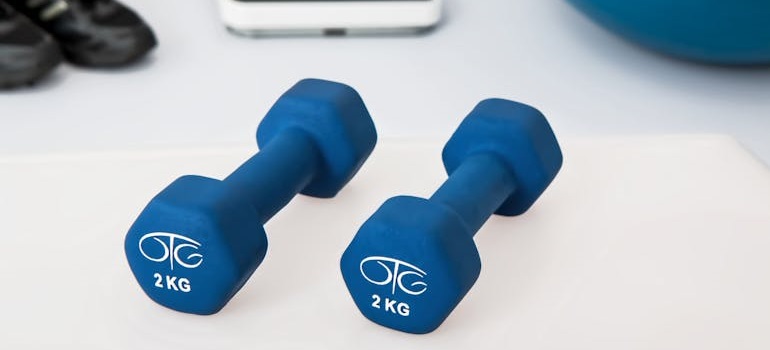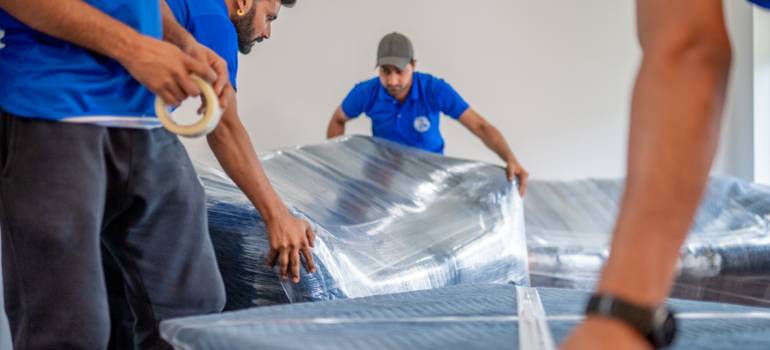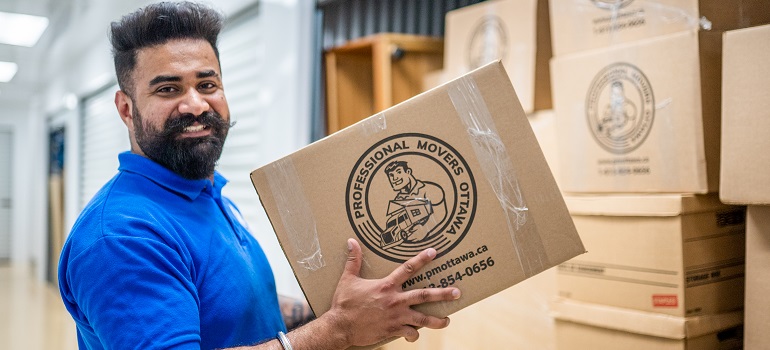Get Your Free Estimate Now
"*" indicates required fields
Storing away with equipment takes planning. Each piece needs specific handling before storage. Sweat, dust, and loose parts can cause damage if not addressed. Also, moisture in storage units can lead to rust and mold. That’s why preparing gym equipment for storage is important. You can’t just throw weights or machines into boxes and call it done. Whether you’re placing items in short-term or long-term storage, the right prep matters. Following a proper process helps keep everything in good condition and it also saves time when unpacking.
Clean all gym equipment before packing
Start by cleaning every piece. Use a damp cloth and mild soap. Avoid harsh cleaners or bleach. Wipe handles, screens, frames, and padding to remove sweat, oil, and dirt buildup. These can attract bacteria and cause odors in storage. Let everything dry fully before packing. Wet items can grow mold or rust. For padded parts, use disinfecting wipes or a light fabric spray. If any covers come off, wash them separately.

Pay special attention to yoga mats, rollers, and resistance bands. They collect more sweat than hard surfaces. Always clean from top to bottom. Avoid soaking fabric or foam padding. Make sure your items smell fresh and feel dry. This step helps prevent damage later. Once you’ve cleaned each item, set it aside for packing. Preparing gym equipment for storage always starts with cleaning. Don’t skip this step. It protects your gear and improves long-term storage quality. If you prefer support during this step, consider hiring a trusted provider like Professional Movers Canada.
Disassemble large machines for easier transport
Larger gym machines often include several connected parts. These should be taken apart before packing. Start with screens, safety handles, or control panels. Use the manual to identify what can be removed. Store bolts, screws, and pins in labeled bags. Keep all parts with the same machine and ake photos before disassembly to guide reassembly later. You can also write notes as reminders. Wrap small pieces in towels or bubble wrap. Label them clearly. Store electrical cords in sealed plastic bags.
Do not leave machines partly assembled. They may break or scratch during the move. Disassembled machines fit better in boxes or storage units. This step also prevents damage to electronic components. Large items like ellipticals or rowers often fold, but full disassembly is safer. Take time to break each machine down carefully. It makes transportation and storage much easier. A reliable packing service in Toronto can make this task more manageable if you need help.
Secure moving parts to avoid damage
Some gym gear includes moving parts like cables, belts, or folding arms. These parts can get damaged in storage. Always secure them before packing. Use zip ties, bungee cords, or Velcro straps. Keep everything tightly fastened. Avoid letting cords hang loose. Wrap them with plastic wrap or soft cloth. Lock folding arms in the closed position. Use stretch wrap or tape to hold them in place. Don’t rely on built-in locks alone. They can shift during transit. Label any tied sections clearly. Note how they were positioned.

Protect screens or touchpads with bubble wrap or foam. Place extra padding around corners and handles. Cables should be disconnected if possible. Store them separately in marked containers. This avoids stress or bending that could damage the machine. Always double-check connections before packing anything away.
Pack free weights and dumbbells safely
Free weights can damage floors or boxes if packed incorrectly. Start by choosing small, sturdy boxes. Avoid large boxes that can’t hold the weight. Wrap each dumbbell or plate in bubble wrap. Secure the wrap with tape. Layer towels or foam at the bottom of the box. This cushions the impact if boxes shift. Stack weights evenly. Keep heavier ones at the bottom. Place padding between each item to prevent scratches. Use thick tape to reinforce box bottoms. Label each box with the total weight. This helps during lifting and placement.

Never overload a box with too many weights. It risks injury and breakage. Preparing gym equipment for storage involves smart packing choices. Rubber-coated weights still need wrapping. They can crack or warp under pressure. Place wrapped weights side by side, not on top of each other. Always lift with care when moving packed weight boxes. You can explore moving services in Toronto for help with heavy lifting.
Store cardio machines the right way
Cardio machines need special care. When preparing them for storage, make sure to:
- Detach and pack safety keys separately
- Unplug machines and coil power cords tightly
- Label each wire and connector before disassembly
- Use soft blankets around frames and rollers
- Bag and label each removed part for easier unpacking
- Place silica packets inside the console housing to absorb moisture
Next, select storage units with 24/7 monitoring and humidity control. Keep cardio gear off the floor using plastic risers or wood panels. In Toronto, climate-controlled storage averages $145 per month for 100 sq. ft, but you should check with service providers for more accurate estimate. Align upright machines side by side, leaving 2 to 3 inches between them. This prevents heat buildup and allows quick checks. Many gym owners use partial packing when relocating from smaller condos or commercial units. Make sure to explore various packing services available for maximum protection of your items.
Handle resistance machines with care
Resistance machines use weight stacks, pulleys, and tension cables. These parts must be protected. Start by disconnecting cables if possible. Wrap pulleys and pivot points in foam. Use shrink wrap to keep stacks together. Label tension settings using painter’s tape. This makes reassembly easier later. Clean all padded surfaces before wrapping. Remove small parts like handles or clips. Store them in labeled containers. Avoid forcing parts to move. Some may lock during disassembly. Cover all metal surfaces with cloth or plastic sheeting. This helps prevent rust and dust buildup.

Avoid placing resistance machines directly on the floor. Use pallets or mats and check for cracks or worn parts before storing. Fix any issues before packing. You’ll save time later. Store resistance machines upright and fully secured to avoid tipping or pressure damage. A proper storage solution helps extend the lifespan of your machines.
Don’t forget small accessories and attachments
Smaller items like yoga mats, TRX straps, massage rollers, and resistance bands need special prep. Begin by separating items by material. Vinyl, rubber, and foam need different care. Clean each item with alcohol-free wipes and allow full air drying. Roll mats tightly and secure them with straps or twine. Use stackable containers with locking lids for band storage. Organize soft accessories in cloth bins with firm sides. For equipment like chin-up bands, use labeled zip-top bags. Add cushioning for brittle parts like ab wheels or stretch bars. Match bins with correct weight ratings to avoid warping or crushing.
- Place desiccant packs inside each sealed container
- Use zippered cases for grip trainers and foot rollers
- Label bins with item type and storage date
- Stack bins no higher than four feet
- Avoid storing elastic items in direct sunlight
- Wrap foam handles in breathable fabric covers
Then, store items in dry, accessible spots near shelves or walls. Maintain 3 inches of airflow around each bin would be an optimal solution. In Toronto-area units, accessory loads often range from 10 to 50 lbs. For delicate items like vibration plates or mini steppers, use wall-mounted storage racks. Many gym enthusiasts opt for full packing to safely prep these overlooked accessories during complex moves.
Choose the right packing materials
Using the correct materials protects your equipment. It’s best to get the best materials from reliable services providers in your area. For instance, if you’re in Toronto, then look for moving supplies Toronto service providers offer. Start with bubble wrap, stretch film, and moving blankets. Bubble wrap cushions hard edges and screens. Stretch film keeps parts together. Moving blankets add extra protection for large machines. Use strong boxes for weights or accessories. Tape all boxes tightly. Avoid thin cardboard that may collapse. Wrap every item individually. This prevents scratches during transport. Use zip ties for cords and cables. Label everything with a marker. Mark which side should face up.

Avoid newspaper as padding. It can stain surfaces. Use foam sheets instead. Store manuals or assembly guides in plastic sleeves. Attach them to each machine. Preparing gym equipment for storage goes faster with proper tools. Get your materials ready before packing. You’ll reduce stress and protect your investment during the move. If you’re handling this yourself, DIY packing services can help you stay organized.
Pick a suitable storage space for gym gear
Where you store gym gear matters. Choose a space that’s clean and dry. Moisture can ruin equipment, so the exercise room in your home should be nice and try. Meanwhile, climate-controlled units are best for long-term storage. They protect electronics and prevent rust. Avoid garages or outdoor sheds. Temperature changes affect metal and plastic parts. Raise equipment off the floor using pallets or boards. This keeps gear dry and reduces contact with dust. Stack items carefully to avoid damage.
Do not overload shelves or corners. Make space to access boxes and machines later. Keep like items together. For example, store all weights in one area. Store accessories in labeled bins on one side. Think about what you’ll need first and place those items near the front. Choose a facility with security and regular access hours. Make sure everything is locked and covered when done.
Check everything before putting it in storage
Before finalizing your storage setup, double-check all items. Confirm each machine is cleaned and wrapped. Ensure all cables are secured and not dangling. Review your packing list. Make sure every part is labeled and boxed. Test box strength by lifting one corner. Boxes should not sag or tear. Check for missing bolts or tools. Fix any loose parts. Lock down wheels or folding sections. Confirm that each item has padding.

If you used storage bins, check that lids are sealed. Secure wrapped machines using tape or tie-downs. Preparing gym equipment for storage isn’t finished without this last step. One final inspection helps avoid surprises later. Mistakes often happen during the final hour. Slow down and check your work. Once confirmed, lock your storage unit. Leave space to move inside later if needed.
Preparing gym equipment for storage made simple with out help!
Packing your gym gear well prevents damage and saves money. Good storage protects machines and small items alike. Clean everything before packing. Label every box or bag. Wrap large and small pieces properly. Use climate-controlled units if available. Avoid placing gear in damp or unventilated rooms. Disassemble when needed and store pieces together. Keep your space organized for easy access. Preparing gym equipment for storage takes time, but it’s worth it. You’ll unpack faster and keep everything in better condition. Use this guide as a reference before your next move. Follow each step for better results. Good storage habits help protect your health and your investment. Start now to prevent problems later. With careful prep, your gear will last longer and stay in top shape.
Contact Us
Get access to a variety of moving and storage Canada solutions:

Contact Our team
Call Professional Movers Canada or fill out our free moving quote form.

Get Your Quote & Plan
Receive an obligation-free estimate and a detailed plan of action for your move.

Enjoy a Professional Move
Leave all the vexing tasks of relocation to our skilled Canada movers.